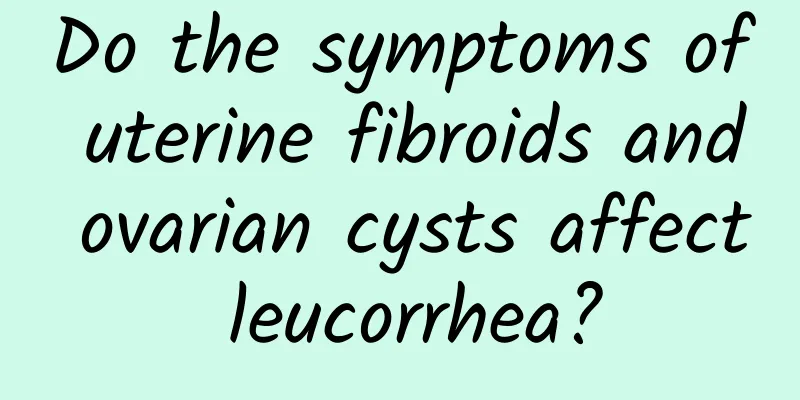Do the symptoms of uterine fibroids and ovarian cysts affect leucorrhea?

|
What are the symptoms of uterine fibroids and ovarian cysts? Do they affect leucorrhea? Most patients with uterine fibroids have no obvious symptoms and are only occasionally discovered during pelvic examinations. If symptoms occur, they are closely related to the location of the fibroid, its growth rate, and whether the fibroid has degenerated. 1. Menstrual changes: The most common symptom is shortened menstrual cycle, increased menstrual flow, prolonged menstrual period, irregular vaginal bleeding, etc. 2. Abdominal mass: The abdomen is swollen, and a mass can be felt in the lower abdomen, accompanied by a feeling of falling. 3. Increased leucorrhea: Increased leucorrhea, sometimes with a large amount of purulent and bloody discharge and necrotic tissue discharge with a foul odor. 4. Pain: Generally, patients do not have abdominal pain, but often have lower abdominal distension, back pain, etc. When the subserosal fibroid pedicle of patients with uterine fibroids is twisted, acute abdominal pain may occur. When the fibroid turns red, the abdominal pain is severe and accompanied by fever. 5. Compression symptoms: When the fibroids grow forward or backward, they can compress the bladder, urethra or rectum, causing frequent urination, dysuria, urinary retention or constipation. When the fibroids grow to both sides, they form broad ligament fibroids, which can compress the ureter and cause hydroureteral or renal pelvis. If they compress the pelvic blood vessels and lymphatic vessels, they can cause lower limb edema. Ovarian cysts often cause abdominal pain and leg pain, and the pain often causes patients to seek emergency treatment. 6. Menstrual disorders Ovarian cysts, even bilateral ovarian cysts, do not usually cause menstrual disorders because they do not destroy all normal ovarian tissues. Some uterine bleeding is not endocrine, but may be caused by ovarian tumors that change the pelvic blood vessels, causing endometrial congestion; or by ovarian malignant tumors that directly metastasize to the endometrium. |
<<: What are the symptoms of endometriosis
>>: Why is the white blood cell count not high in pelvic inflammatory disease?
Recommend
What should not be eaten after uterine fibroid surgery? Dietary taboos after uterine fibroid surgery
Suffering from uterine fibroids is also a blessin...
What are the early symptoms of uterine fibroids? Drug treatment methods for uterine fibroids
Uterine fibroids are a disease with a high incide...
Is moderate chronic cervicitis serious? Several treatments for moderate chronic cervicitis
Cervicitis is a common gynecological disease, mos...
What is the size range of the gestational sac for painless abortion?
If you want to have a painless abortion, you need...
What medicine is good for endometritis and pelvic inflammatory disease
Endometritis and pelvic inflammatory disease are ...
Three reasons why middle-aged women are prone to uterine fibroids
The medical community has conducted detailed rese...
Will pregnant women have miscarriage if they eat pickled pepper chicken feet?
Pickled pepper chicken feet is a common snack, lo...
How often do cervical warts recur?
As society becomes more open, it has also led to ...
At what age do women reach menopause?
Women usually go through menopause around age 50,...
What are the causes of cervical erosion? Five adverse conditions can cause cervical erosion
Cervical erosion is a common disease that trouble...
What medicine is used to treat malignant uterine fibroids?
What medicine is used to treat malignant uterine ...
How to prevent and care for patients with hyperplastic vulvar leukoplakia in daily life
After suffering from hyperplastic vulvar leukopla...
How much does intrauterine adhesion surgery cost?
Experts say that the cost of treating intrauterin...
Diarrhea caused 2 cup sizes to fall off? TCM: Too exaggerated
The weather is cold in winter, and many people li...
Experts introduce dietary therapy for uterine fibroids
"What are the dietary treatments for uterine...









